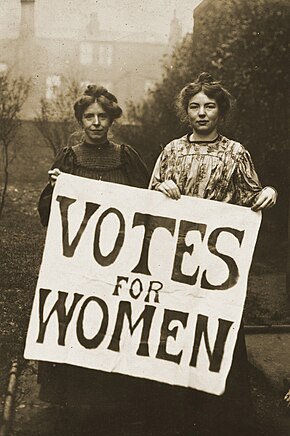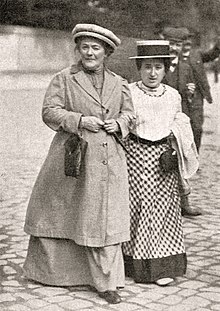Παγκόσμια ημέρα της γυναίκας: Διαφορά μεταξύ των αναθεωρήσεων
Χωρίς σύνοψη επεξεργασίας |
Χωρίς σύνοψη επεξεργασίας |
||
| Γραμμή 23: | Γραμμή 23: | ||
Στο [[Λονδίνο]] πραγματοποιήθηκε πορεία από το Μπόου μέχρι την πλατεία Τραφάλγκαρ προς υποστήριξη της γυναικείας ψηφοφορίας στις 8 Μαρτίου 1914. Η [[Σίλβια Πάνκχερστ]] συνελήφθη μπροστά από το σταθμό Τσάρινγκ Κρος πηγαίνοντας να μιλήσει στην πλατεία Τραφάλγκαρ.<ref>{{cite news|title=Suffragist Disorders|url=http://www.thetimes.co.uk/tto/archive/article/1914-03-09/5/1.html#start%3D1785-01-01%26end%3D1985-12-31%26terms%3D%22Sylvia%20Pankhurst%22%20arrested%26back%3D/tto/archive/find/%252522Sylvia+Pankhurst%252522+arrested/w:1785-01-01%7E1985-12-31/o:date/4%26prev%3D/tto/archive/frame/goto/%252522Sylvia+Pankhurst%252522+arrested/w:1785-01-01%7E1985-12-31/o:date/32%26next%3D/tto/archive/frame/goto/%252522Sylvia+Pankhurst%252522+arrested/w:1785-01-01%7E1985-12-31/o:date/34|accessdate=May 9, 2014|newspaper=The Times|date=March 9, 1914}}</ref> |
Στο [[Λονδίνο]] πραγματοποιήθηκε πορεία από το Μπόου μέχρι την πλατεία Τραφάλγκαρ προς υποστήριξη της γυναικείας ψηφοφορίας στις 8 Μαρτίου 1914. Η [[Σίλβια Πάνκχερστ]] συνελήφθη μπροστά από το σταθμό Τσάρινγκ Κρος πηγαίνοντας να μιλήσει στην πλατεία Τραφάλγκαρ.<ref>{{cite news|title=Suffragist Disorders|url=http://www.thetimes.co.uk/tto/archive/article/1914-03-09/5/1.html#start%3D1785-01-01%26end%3D1985-12-31%26terms%3D%22Sylvia%20Pankhurst%22%20arrested%26back%3D/tto/archive/find/%252522Sylvia+Pankhurst%252522+arrested/w:1785-01-01%7E1985-12-31/o:date/4%26prev%3D/tto/archive/frame/goto/%252522Sylvia+Pankhurst%252522+arrested/w:1785-01-01%7E1985-12-31/o:date/32%26next%3D/tto/archive/frame/goto/%252522Sylvia+Pankhurst%252522+arrested/w:1785-01-01%7E1985-12-31/o:date/34|accessdate=May 9, 2014|newspaper=The Times|date=March 9, 1914}}</ref> |
||
Στις 8 Μαρτίου του 1917 (σύμφωνα με το Γρηγοριανό ημερολόγιο), στην πρωτεύουσα της Ρωσικής Αυτοκρατορίας Πετρούπολη, οι εργάτριες κλωστοϋφαντουργίας διαδήλωσαν γεμίζοντας τους δρόμους όλης την πόλη. Αυτό σηματοδότησε την αρχή της [[ρώσικη επανάσταση|ρωσικής επανάστασης]].<ref>{{cite web|url=https://ria.ru/revolution_postup/20170306/1489217048.html|title=February Revolution|publisher=[[RIA Novosti]]|accessdate=7 March 2017}}</ref><ref name="UN" />Οι γυναίκες στην Αγία Πετρούπολη έκαναν απεργία εκείνη την ημέρα για το "Ψωμί και την Ειρήνη" - απαιτώντας το τέλος του [[Α΄Παγκόσμιος Πόλεμος|Α 'Παγκοσμίου Πολέμου]], τον τερματισμό των ελλείψεων τροφίμων και το τέλος του τσαρισμού<ref name="mmf1" /> [[Leon Trotsky]] wrote, "23 February (8th March) was International Woman's Day and meetings and actions were foreseen. But we did not imagine that this 'Women's Day' would inaugurate the revolution. Revolutionary actions were foreseen but without date. But in the morning, despite the orders to the contrary, textile workers left their work in several factories and sent delegates to ask for support of the strike… which led to mass strike... all went out into the streets."<ref name="mmf1" /> Seven days later, the [[Emperor of Russia]], [[Nicholas II]] abdicated and the [[Russian Provisional Government|provisional Government]] granted women the right to vote.<ref name="unevents" /> |
|||
Following the [[October Revolution]], the [[Bolshevik]] [[Alexandra Kollontai]] and [[Vladimir Lenin]] made it an [[Public holiday|official holiday]] in the Soviet Union, but it was a working day until 1965. On May 8, 1965 by the decree of the [[USSR]] [[Presidium of the Supreme Soviet]] International Women's Day was declared a non-working day in the USSR "in commemoration of the outstanding merits of Soviet women in communistic construction, in the defense of their Fatherland during the Great Patriotic War, in their heroism and selflessness at the front and in the rear, and also marking the great contribution of women to strengthening friendship between peoples, and the struggle for peace. But still, women's day must be celebrated as are other holidays." |
Following the [[October Revolution]], the [[Bolshevik]] [[Alexandra Kollontai]] and [[Vladimir Lenin]] made it an [[Public holiday|official holiday]] in the Soviet Union, but it was a working day until 1965. On May 8, 1965 by the decree of the [[USSR]] [[Presidium of the Supreme Soviet]] International Women's Day was declared a non-working day in the USSR "in commemoration of the outstanding merits of Soviet women in communistic construction, in the defense of their Fatherland during the Great Patriotic War, in their heroism and selflessness at the front and in the rear, and also marking the great contribution of women to strengthening friendship between peoples, and the struggle for peace. But still, women's day must be celebrated as are other holidays." |
||
Έκδοση από την 09:14, 8 Μαρτίου 2018
 |
Αυτό το λήμμα υπόκειται σε έντονη επεξεργασία αυτή τη στιγμή και για αρκετή ώρα. |

Η Παγκόσμια ημέρα της γυναίκας εορτάζεται στις 8 Μαρτίου κάθε χρόνου.[1] ως ημέρα μνήμης των αγώνων του κινήματος για τα δικαιώματα των γυναικών.
Ενώ η πρώτη τήρηση της Ημέρας της Γυναίκας πραγματοποιήθηκε στις 28 Φεβρουαρίου 1909 στη Νέα Υόρκη, η 8η Μαρτίου προτάθηκε από τη Διεθνή Διάσκεψη Γυναικών του 1910 ώστε να καθιερωθεί μια «Διεθνής Ημέρα της Γυναίκας». Αφού οι γυναίκες κέρδισαν το δικαίωμα ψήφου στη Σοβιετική Ρωσία το 1917, η 8η Μαρτίου καθιερώθηκε ως εθνική αργία εκεί. Την εποχή εκείνη εορταζόταν κατά κύριο λόγο από το σοσιαλιστικό κίνημα και τις κομμουνιστικές χώρες μέχρι την υιοθέτησή της το 1975 από τα Ηνωμένα Έθνη.
Ιστορία


Η πρώτη τήρηση της "Ημέρας της Γυναίκας", ονομαζόταν «Εθνική Ημέρα της Γυναίκας» [2] και πραγματοποιήθηκε στις 28 Φεβρουαρίου του 1909 στη Νέα Υόρκη, όπου διοργανώθηκε από το Σοσιαλιστικό Κόμμα της Αμερικής [3] κατόπιν εισήγησης της Τερεζα Μαλκίελ.[4] Αν και υπήρξαν ισχυρισμοί ότι η μέρα γιόρταζε την διαμαρτυρία των εργατριών στην κατασκευή ενδυμάτων στην Νέα Υόρκη στις 8 Μαρτίου του 1857, οι ερευνητές τους καταρρίπτουν ως μύθο.[5][6][7]
Στις 19 Αυγούστου 1910 διοργανώθηκε Διεθνής Διάσκεψη Γυναικών ως πρόδρομος της γενικής συνάντησής της Δεύτερης Διεθνούς Σοσιαλιστικής Κοινότητας στη Κοπεγχάγη της Δανίας.[8] Εμπνευσμένη εν μέρει από τους Αμερικανούς σοσιαλιστές, η Γερμανίδα Σοσιαλίστρια Λουίζε Τσίτς πρότεινε την καθιέρωση μιας ετήσιας Διεθνούς Ημέρας της Γυναίκας και υποστηρίχθηκε από τη συνάδελφο σοσιαλίστρια και αργότερα κομμουνίστρια ηγέτιδα Κλάρα Τσέτκιν, υποστηριζόμενη από την Κέιτ Ντούκε χωρίς όμως να καθοριστεί συγκεκριμένη ημερομηνία.[9][10] Οι αντιπρόσωποι (100 γυναίκες από 17 χώρες) συμφώνησαν με την ιδέα ως μέσο προώθησης των ίσων δικαιωμάτων, συμπεριλαμβανομένου του δικαιώματος του εκλέγειν για τις γυναίκες.[11] Το επόμενο έτος, στις 19 Μαρτίου 1911, η Παγκόσμια ημέρα της γυναίκας σηματοδοτήθηκε για πρώτη φορά με τη συμμετοχή πάνω από ένός εκατομμυρίου ανθρώπων στην Αυστρία, τη Δανία, τη Γερμανία και την Ελβετία.[3] Μόνο στην Αυστροουγγρική Αυτοκρατορία υπήρξαν 300 διαδηλώσεις.[9] Στη Βιέννη, οι γυναίκες παρέλασαν στην Ρίνγκστρασσε και σήκωσαν πανό για να τιμούν τους μάρτυρες της Κομμούνας των Παρισίων.[9] Οι γυναίκες ζήτησαν να τους δοθεί το δικαίωμα του εκλέγειν και της κατοχής δημοσίων αξιωμάτων. Διαμαρτυρήθηκαν επίσης κατά της διάκρισης λόγω φύλου στην εργασία .[1] Οι Αμερικανοί συνέχισαν να γιορτάζουν την Εθνική Ημέρα της Γυναίκας την τελευταία Κυριακή του Φεβρουαρίου.[9]

Το 1913 οι Ρωσίδες όρισαν την πρώτη τους Διεθνή Ημέρα της Γυναίκας το τελευταίο Σάββατο του Φεβρουαρίου (σύμφωνα με το ιουλιανό ημερολόγιο που στη συνέχεια χρησιμοποιήθηκε στη Ρωσία).[12] Παρόλο που υπήρξαν κάποιες απεργίες, πορείες και άλλες διαμαρτυρίες από γυναίκες κατά τα έτη που προηγήθηκαν μέχρι το 1914, καμία από αυτές δεν συνέβη στις 8 Μαρτίου.[12] Το 1914 έλαβε χώρα η Διεθνής Ημέρα της Γυναίκας στις 8 Μαρτίου, πιθανόν επειδή η ημέρα αυτή ήταν Κυριακή και έκτοτε πραγματοποιείται πάντα αυτήν την ημερομηνία σε όλες τις χώρες.[12] Η τήρηση της Ημέρας στη Γερμανία το 1914 ήταν αφιερωμένη στο δικαίωμα ψήφου των γυναικών, το οποίο οι Γερμανίδες απέκτησαν τελικά το 1918.[12][13]
Στο Λονδίνο πραγματοποιήθηκε πορεία από το Μπόου μέχρι την πλατεία Τραφάλγκαρ προς υποστήριξη της γυναικείας ψηφοφορίας στις 8 Μαρτίου 1914. Η Σίλβια Πάνκχερστ συνελήφθη μπροστά από το σταθμό Τσάρινγκ Κρος πηγαίνοντας να μιλήσει στην πλατεία Τραφάλγκαρ.[14]
Στις 8 Μαρτίου του 1917 (σύμφωνα με το Γρηγοριανό ημερολόγιο), στην πρωτεύουσα της Ρωσικής Αυτοκρατορίας Πετρούπολη, οι εργάτριες κλωστοϋφαντουργίας διαδήλωσαν γεμίζοντας τους δρόμους όλης την πόλη. Αυτό σηματοδότησε την αρχή της ρωσικής επανάστασης.[15][1]Οι γυναίκες στην Αγία Πετρούπολη έκαναν απεργία εκείνη την ημέρα για το "Ψωμί και την Ειρήνη" - απαιτώντας το τέλος του Α 'Παγκοσμίου Πολέμου, τον τερματισμό των ελλείψεων τροφίμων και το τέλος του τσαρισμού[12] Leon Trotsky wrote, "23 February (8th March) was International Woman's Day and meetings and actions were foreseen. But we did not imagine that this 'Women's Day' would inaugurate the revolution. Revolutionary actions were foreseen but without date. But in the morning, despite the orders to the contrary, textile workers left their work in several factories and sent delegates to ask for support of the strike… which led to mass strike... all went out into the streets."[12] Seven days later, the Emperor of Russia, Nicholas II abdicated and the provisional Government granted women the right to vote.[3]
Following the October Revolution, the Bolshevik Alexandra Kollontai and Vladimir Lenin made it an official holiday in the Soviet Union, but it was a working day until 1965. On May 8, 1965 by the decree of the USSR Presidium of the Supreme Soviet International Women's Day was declared a non-working day in the USSR "in commemoration of the outstanding merits of Soviet women in communistic construction, in the defense of their Fatherland during the Great Patriotic War, in their heroism and selflessness at the front and in the rear, and also marking the great contribution of women to strengthening friendship between peoples, and the struggle for peace. But still, women's day must be celebrated as are other holidays."
From its official adoption in Soviet Russia following the Revolution in 1917, the holiday was predominantly celebrated in communist countries and by the communist movement worldwide. It was celebrated by the communists in China from 1922.[9] After the founding of the People's Republic of China on October 1, 1949 the State Council proclaimed on December 23 that March 8 would be made an official holiday with women in China given a half-day off.[16]
Communist leader Dolores Ibárruri led a women's march in Madrid in 1936 on the eve of the Spanish Civil War.[9]
The United Nations began celebrating International Women's Day in the International Women's Year, 1975. In 1977, the United Nations General Assembly invited member states to proclaim March 8 as the UN Day for women's rights and world peace.[17]
Δείτε ακόμα
Παραπομπές
- ↑ 1,0 1,1 1,2 «UN WomenWatch: International Women's Day –». UN.org. Ανακτήθηκε στις 21 Φεβρουαρίου 2013.
- ↑ «International Women's Day History | International Women's Day | The University of Chicago». iwd.uchicago.edu (στα Αγγλικά). Ανακτήθηκε στις 7 Απριλίου 2017.
- ↑ 3,0 3,1 3,2 «United Nations page on the background of the IWD». Un.org. Ανακτήθηκε στις 8 Μαρτίου 2012.
- ↑ Miller, Sally M. (December 1978). «From Sweatshop Worker to Labor Leader: Theresa Malkiel, A Case Study». American Jewish History 68 (2): 197.
- ↑ Temma Kaplan, "On the Socialist Origins of International Women's Day", in: Feminist Studies, 11, 1985, S. 163–171. (PDF Αρχειοθετήθηκε June 15, 2007, στο Wayback Machine.)
- ↑ Liliane Kandel / Françoise Picq, "Le Mythe des origines à propos de la journée internationale des femmes" Αρχειοθετήθηκε September 27, 2013, στο Wayback Machine., in: La Revue d'en face, 12, 1982, S. 67–80.
- ↑ Angela Howard Zophy, Handbook of American Women's History, Garland, 1991, 187.
- ↑ Rochelle Goldberg Ruthchild, "From West to East: International Women’s Day, the First Decade”, Aspasia: The International Yearbook of Central, Eastern, and Southeastern European Women's and Gender History, vol. 6 (2012): 1-24.
- ↑ 9,0 9,1 9,2 9,3 9,4 9,5 Temma Kaplan, "On the Socialist Origins of International Women's Day", Feminist Studies, 11/1 (Spring, 1985)
- ↑ «History of International Women's Day». United Nations. Ανακτήθηκε στις 26 Μαΐου 2012.
- ↑ «About International Women's Day». Internationalwomensday.com. 8 Μαρτίου 1917. Ανακτήθηκε στις 26 Φεβρουαρίου 2016.
- ↑ 12,0 12,1 12,2 12,3 12,4 12,5 «8th of March – International woman's day: in search of lost memory». Αρχειοθετήθηκε από το πρωτότυπο στις 13 Μαρτίου 2011. Ανακτήθηκε στις 14 Μαρτίου 2014.
- ↑ «Women's Suffrage». Inter-Parliamentary Union. Ανακτήθηκε στις 26 Ιανουαρίου 2014.
- ↑ «Suffragist Disorders». The Times. March 9, 1914. http://www.thetimes.co.uk/tto/archive/article/1914-03-09/5/1.html#start%3D1785-01-01%26end%3D1985-12-31%26terms%3D%22Sylvia%20Pankhurst%22%20arrested%26back%3D/tto/archive/find/%252522Sylvia+Pankhurst%252522+arrested/w:1785-01-01%7E1985-12-31/o:date/4%26prev%3D/tto/archive/frame/goto/%252522Sylvia+Pankhurst%252522+arrested/w:1785-01-01%7E1985-12-31/o:date/32%26next%3D/tto/archive/frame/goto/%252522Sylvia+Pankhurst%252522+arrested/w:1785-01-01%7E1985-12-31/o:date/34. Ανακτήθηκε στις May 9, 2014.
- ↑ «February Revolution». RIA Novosti. Ανακτήθηκε στις 7 Μαρτίου 2017.
- ↑ «Anniversaries of important events». China Factfile. Chinese Government. Ανακτήθηκε στις 28 Αυγούστου 2011.
- ↑ «International Women's Day». United Nations.
Επιπλέον ανάγνωση
- "The socialist roots of International Women's Day". Al Jazeera America. March 7, 2015
- Rochelle Goldberg Ruthchild, "From West to East: International Women’s Day, the First Decade”, Aspasia: The International Yearbook of Central, Eastern, and Southeastern European Women's and Gender History, vol. 6 (2012): 1-24.
